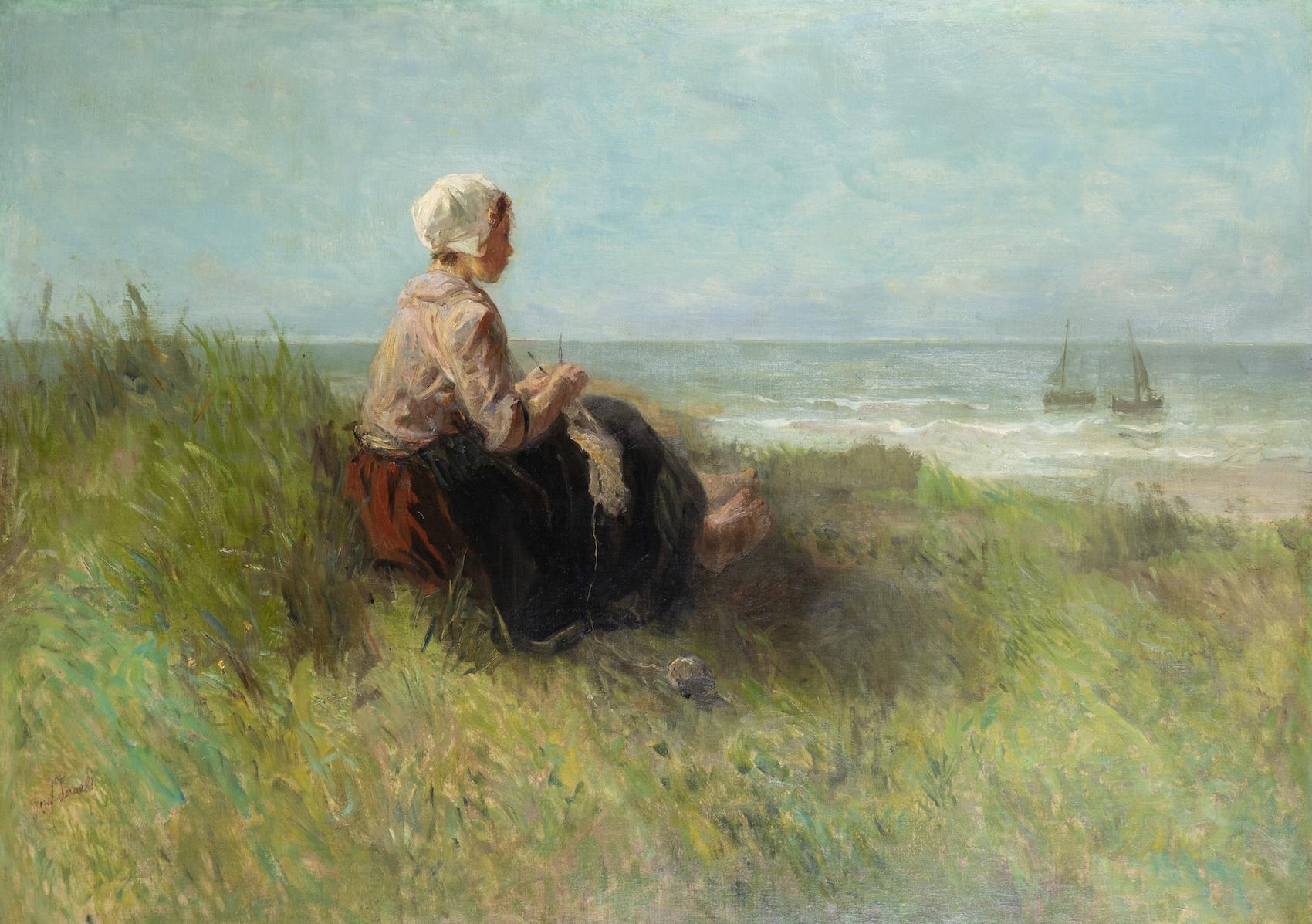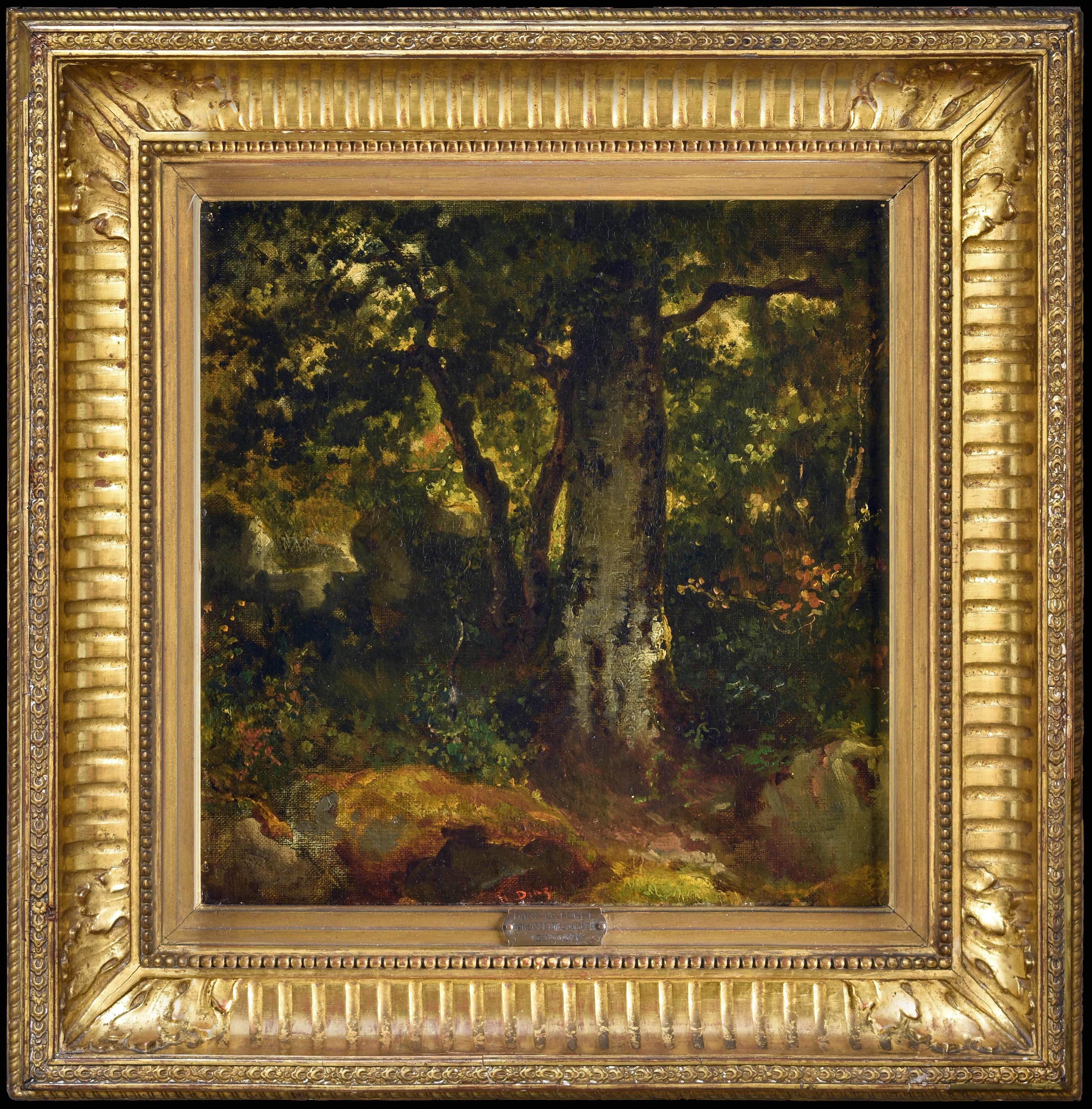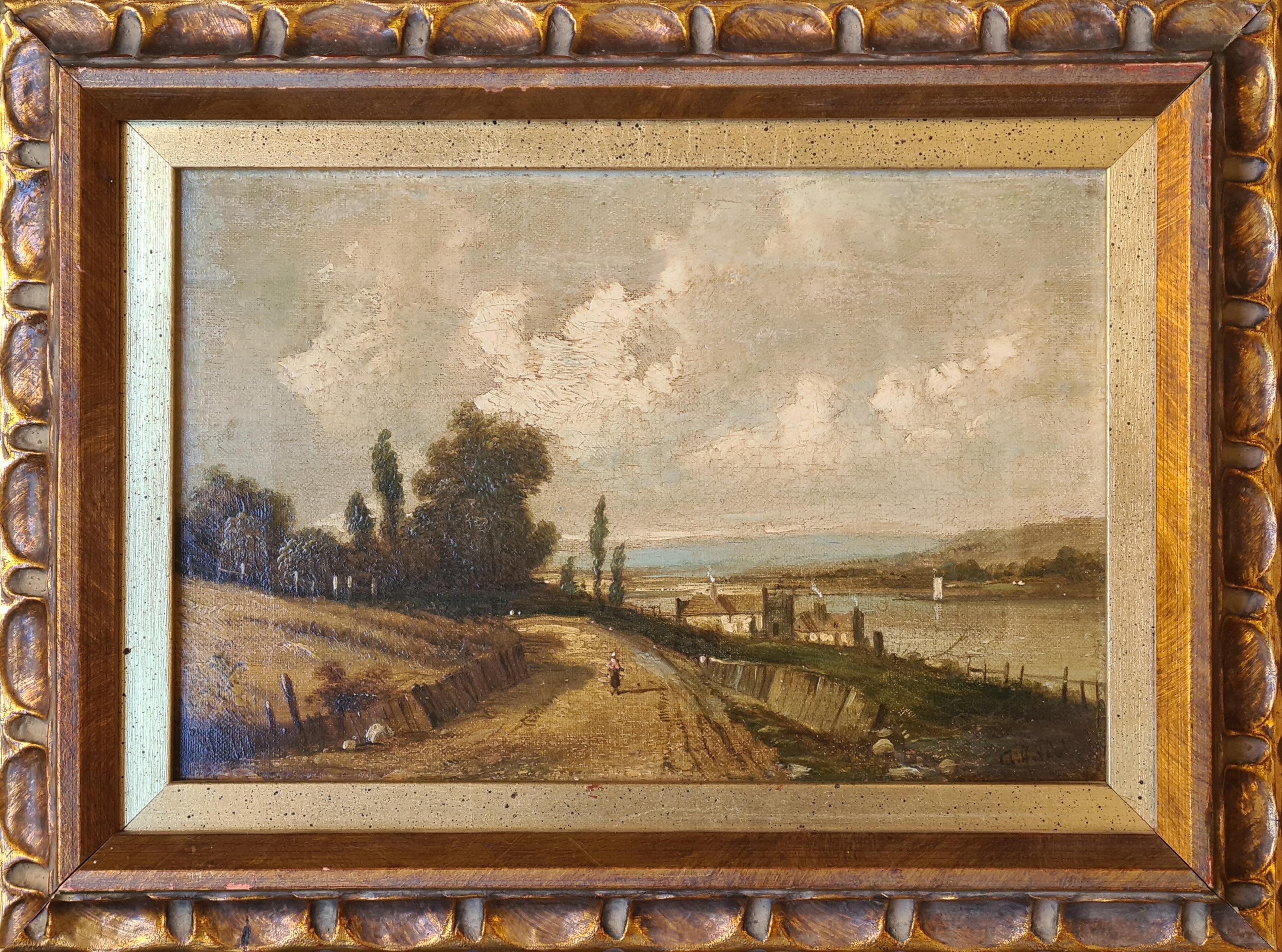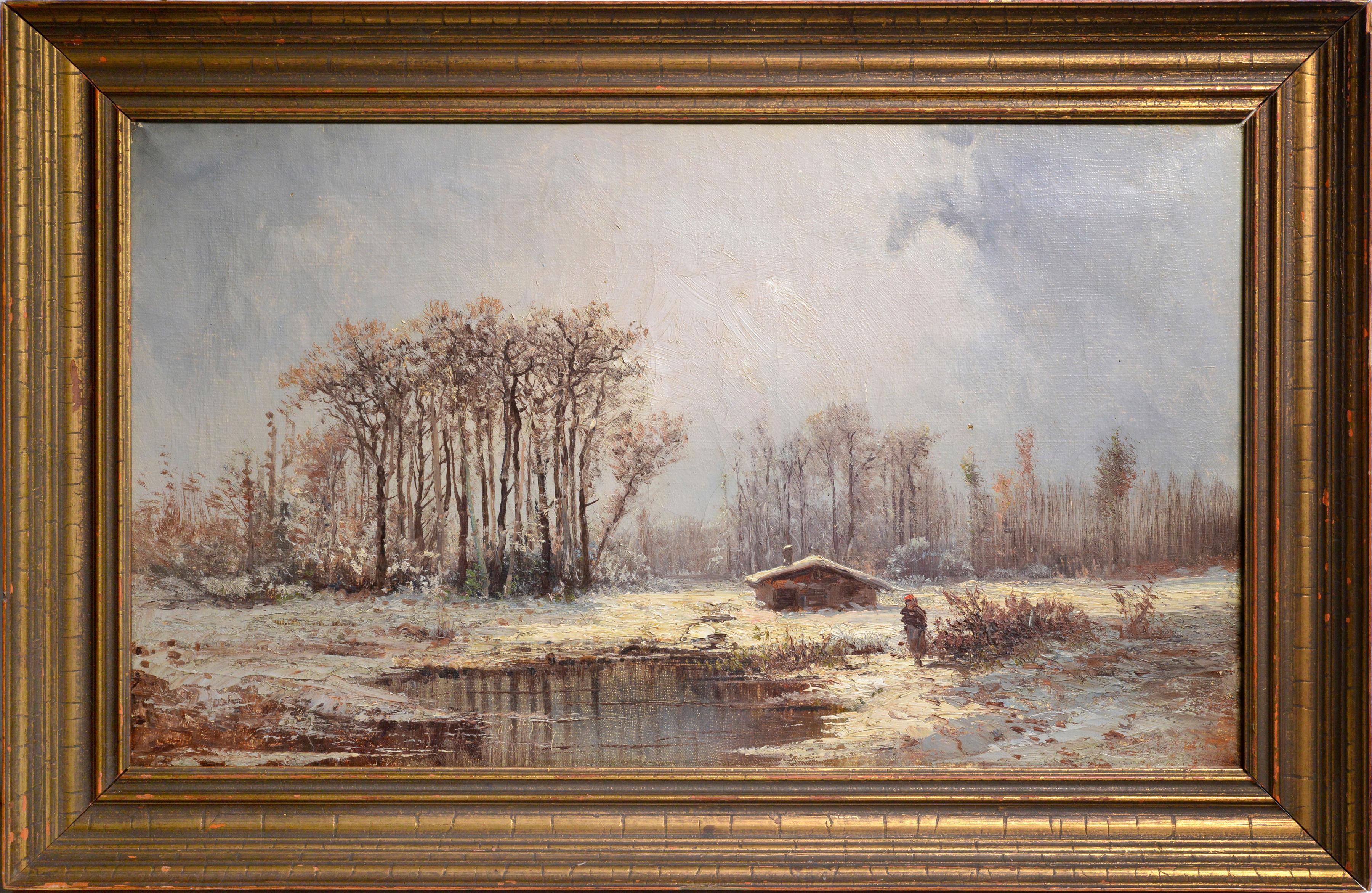Items Similar to Le repos des le moissonneurs - Barbizon Figurative Pastel by Leon Lhermitte
Want more images or videos?
Request additional images or videos from the seller
1 of 18
Léon Augustin LhermitteLe repos des le moissonneurs - Barbizon Figurative Pastel by Leon Lhermittec.1885
c.1885
About the Item
Signed figures in landscape pastel on canvas circa 1885 by French Barbizon painter Leon Augustin Lhermitte. The piece depicts two children resting beside a large haystack in farmland on a bright summer's day.
Signature:
Signed lower right
Dimensions:
Framed: 24"x30"
Unframed: 16"x22"
Provenance:
Private collection - United States
Léon Augustin Lhermitte was the son of a school teacher. He painted from a very early age and settled in Paris in 1863, enrolling in the École Impériale de Dessin. His teacher was Lecocq de Boisboudran. In the early days of his career he earned a living doing illustrations for boxes of sweets and the catalogues of the cabinet-makers of the Faubourg St-Antoine, as well as publishing houses. In 1879 he went to Great Britain, to which he returned frequently. The same year he met the art dealer Paul Durant-Ruel who exhibited his works. He was one of the founders of the Société Nationale des Beaux-Arts, of which he became vice-president.
Lhermitte initially produced charcoal drawings which revealed his deep feeling for nature. His first attempt, Banks of the Marne near Alfort, caused a sensation. Following this he executed canvases, showing himself to be a fine landscape artist and a skilful draughtsman. He painted scenes from rural life almost exclusively and benefited from exceptional interest generated by the prizes awarded to the works of J. F. Millet. But although he was very much affected by the work of the painter of Angelus, he himself sought only the pictorial element and not a synthetic translation. Many other French masters of the period share his completely objective vision, for example Bastien Lepage, Roll, J. C. Cazin and Rafaelli. Like them, he put into practice very early on the technique of 'clear painting' made fashionable by the pursuit of Impressionism. But this group of artists borrowed from this method only those elements which appealed to public taste, and ignored chromatic elements. Lhermitte also paid the price for the easy success of those early days. His peasants, which found general favour with the public at the time, nowadays seem rather feeble alongside Camille Pissarro's renderings of the same subject.
However, in order to pass judgement on an artist such as Lhermitte, it is necessary to understand the era in which he worked, the era in which Realism was the only acceptable approach. It was in the atmosphere of the 'Théâtre Libre' of Antoine and the novels of Maupassant, Zola and their imitators that this type of art developed. In this context, Lhermitte is recognised as having painted the life of the peasants with great powers of objective observation and great insight into types and physiognomies. Nothing escaped his implacable eye and his bold and vigorous hand was guided by a lucid mind. The simplest elements of nature take on an air of true grandeur in his painting, despite their romantic and sentimental aspects. He is highly regarded both in France and in other countries by art lovers who look for nothing more than an attractive subject expertly painted. Among his most noteworthy works, outside those in museums, are: Les Halles, Washing the Sheep, Haymaking Time, and his large decorative panel for the Sorbonne, Claude Bernard. He illustrated A. Thieuret's Rural Life (La Vie Rustique).
He made his debut in 1864 in Paris at the Salon des Artistes Français. He subsequently took part in numerous collective exhibitions, notably the Exposition Universelle of 1900, in which he showed seven paintings, three pastels and four drawings. His early works gained him a third-place medal in 1874, a second-place medal in 1880, and the Grand Prix at the 1889 Exposition Universelle in Paris. He received a diploma of honour in Dresden in 1890 and was decorated with the Légion d'Honneur in 1884, promoted to Officier in 1884 and to Commandeur in 1911. He was elected to the Institut de France in 1905.
Museum and Gallery Holdings:
Albany (Institute of History and Art): Landscape
Amiens: Death and the Woodcutter
Boston (MFA): Soul of the Humble
Buffalo (Albright-Knox AG): Haymaking Time
Carcassonne: Harvest
Château-Thierry (Mus. Jean-de-La-Fontaine): View of Château-Thierry
Chicago (AI): Sheafing the Hay
Florence (Uffizi): Portrait of the Artist
Montreal (Learmont): Ruins of Château-Thierry
Moscow (State Tretyakov Gal.): Le Tréport; Small Courtyard in Normandy
New York (Metropolitan Mus. of Art): Grape Harvest (1884); Soul of the Humble (1905)
Paris (MAM): Jazz Quartet
Paris (Mus. d'Orsay): Harvesters' Wages
Paris (Mus. du Petit Palais): Les Halles
Rheims: Wine Press
St Louis (Washington University): Harvest (1883, oil on canvas); Haymaking Time (1891, oils on canvas, two paintings)
St-Quentin: Pardon of Ploumanac'h
Washington DC (Corcoran Gal. of Art): Family of Harvesters
- Creator:Léon Augustin Lhermitte (1844-1925, French)
- Creation Year:c.1885
- Dimensions:Height: 24 in (60.96 cm)Width: 30 in (76.2 cm)
- Medium:
- Movement & Style:
- Period:
- Condition:Very good original condition.
- Gallery Location:Marlow, GB
- Reference Number:
Léon Augustin Lhermitte
L'hermitte often travelled to Britanny, as he was fascinated by the rural life there. His
work was shown in Paris but he also had a dealer who brought his pieces to the US, Canada, and Britain. Moreover, his work also spread through commissions in illustrated magazines. Vincent Van Gogh wrote "If every month Le Monde Illustré published one of his compositions...it would be a great pleasure for me to be able to follow it. It is certain that for years I have not seen anything as beautiful as this scene by L'hermitte...I am too preoccupied by L'hermitte this evening to be able to talk of other things." Originally from north-eastern France, Léon Augustin L'hermitte moved to Paris in time to attend the Salon des Refuses in 1863, and while studying at the École des Beaux Arts he gained recognition after his show in the Paris Salon in 1874. His many awards include the French Legion of Honour (1884) and the Grand Prize at the Exposition Universelle in 1889.
About the Seller
5.0
Platinum Seller
These expertly vetted sellers are 1stDibs' most experienced sellers and are rated highest by our customers.
Established in 2001
1stDibs seller since 2016
673 sales on 1stDibs
Typical response time: 3 hours
- ShippingRetrieving quote...Ships From: Marlow, United Kingdom
- Return PolicyA return for this item may be initiated within 3 days of delivery.
More From This SellerView All
- Barques de Peche - Post Impressionist Landscape Oil by Henri Le SidanerBy Henri Le SidanerLocated in Marlow, BuckinghamshireSigned post impressionist landscape oil on canvas by French painter Henri Le Sidaner. This stunning piece depicts two fishing boats moored in a fishing village at sunset. The last l...Category
1890s Post-Impressionist Landscape Paintings
MaterialsOil, Canvas
- Le Pont de Charenton - Post Impressionist Landscape Oil by Nathan GrunsweighLocated in Marlow, BuckinghamshireSigned post impressionist oil on canvas riverscape circa 1920 but Polish painter Nathan Grunsweigh. The work depicts a view of the bridge over the River Seine in Paris. A beautifully...Category
1920s Post-Impressionist Landscape Paintings
MaterialsCanvas, Oil
- Bathers on the Beach - Post Impressionist Landscape by Jacques-Emile BlancheBy Jacques Emile BlancheLocated in Marlow, BuckinghamshireSigned post impressionist oil on canvas landscape by French painter Jacques-Emile Blanche. The work depicts crowds of people enjoying a day at Brighton beach on the south coast of England. Bathers are dotted across the sandy beach with the pier on the right hand of the scene and the Grand Hotel behind. Signature: Signed lower right Dimensions: Framed: 29.5"x47.5" Unframed: 22.5"x39.5" Provenance: Private collection - Italy This work will be included in the catalogue raisonne of the work of Jacques Emile Blanche currently under preparation by Dr Jane Roberts & Muriel Molines Blanche received training from Gervex and Fernand Humbert. His grandfather was Émile Antoine Blanche, the psychiatrist who treated the poet Gérard de Nerval on several occasions. He was awarded a gold medal at the Exposition Universelle in Paris in 1900, and was a Commander of the Légion d'Honneur. He was well known in French and British artistic circles, and married the daughter of John Lemoine, the leader of the Diary of the Proceedings ( Journal des Débats), and author of the Life of Brummel. He exhibited his works in London and Paris. Blanche had a wide circle of acquaintances, and the list of portraits which he executed is indicative of the diversity of those who used to meet at his home: Henri Bergson; Stéphane Mallarmé; Henry Bernstein (1902); André Gide (1912); Anna de Noailles (1912); Jean Cocteau (1912); Igor Stravinsky (1915); Francis Jammes (1917); Paul Claudel (1919); Jean Giraudoux; Paul Valéry; Marcel Proust; Max Jacob (1921); Maeterlinck (1931); Debussy; Antoine Bourdelle; George Moore; André Maurois; François Mauriac; Maréchal Foch and the Princess de Broglie. He also wrote novels, which were more or less autobiographical, and essays, such as From David to Degas; Dates; From Gauguin to the Negro Review; Journals of an Artist ( De David à Degas; Dates; De Gauguin à la Revue nègre; Cahiers d'un artiste) in six volumes, and Manet. During meetings at his studio, he used to collect any snippets that would flesh out the essays he wrote, which alternated between being sharp and emotive. He gave them in series to the magazine Comoedia, under the title of Studio Talk. It was said that he aroused tremendous debate, notably with André Lhote, a painter younger than himself, who also doubled as a critic. The latter initially attempted to define the main characteristics of the art of the 'rebellious and charming Jacques Émile Blanche,' but subsequently treated him less generously, referring to a painter 'attached to the notion of 'high-and-mighty' genre painting.' He added that this sort of painting was marvellously illustrated by Manet. The quality of his flat surfaces, the precious greys and silvery light effects cause Jacques Émile Blanche to be compared more with Manet, whom he admired, than with the Impressionists, with whom he was compared in terms of his early works. Nevertheless, his outdoor backgrounds with traces of sometimes vivid colours have something in common with them. In the aftermath of World War I, he spent a long time on an enormous composition entitled Tribute to those who Died in the War. It was executed in a style which was totally different to his work as a whole. He offered this work to the church in Offranville near Dieppe. He also donated around 100 of his works to the Musée des Beaux-Arts in Rouen. He regularly exhibited in Paris, at the Salon of the Société Nationale des Beaux-Arts (also known as the Salon de Mars) from the time it was founded in 1890. At the time of the initial exhibitions held by the Société Nationale des Beaux-Arts, he rapidly gained fame by exhibiting such portraits as Paul Adam and Charles Cottet...Category
Mid-20th Century Post-Impressionist Landscape Paintings
MaterialsCanvas, Oil
- Les Grands Boulevards - Post Impressionist City Landscape Oil by Lucien AdrionBy Lucien AdrionLocated in Marlow, BuckinghamshireSigned figures in landscape oil on canvas circa 1920 by French post impressionist painter Lucien Adrion. The painting depicts people going about their daily lives on the streets of P...Category
1920s Post-Impressionist Landscape Paintings
MaterialsCanvas, Oil
- Evening - New York - Impressionist Landscape Oil Painting by Johann BerthelsenBy Johann Berthelsen, 1883-1972Located in Marlow, BuckinghamshireStunning oil on canvas circa 1955 by American impressionist painter Johann Henrik Carl Berthelsen. The piece depicts a view of the illuminated waterfront buildings from the East Rive...Category
1950s American Impressionist Landscape Paintings
MaterialsCanvas, Oil
- La Marchande de Fleurs - French Realist Figurative Oil by Victor GilbertBy Victor Gabriel GilbertLocated in Marlow, BuckinghamshireSigned figurative oil on original canvas by French realist painter Victor Gabriel Gilbert. The work shows a flower seller filling a young girl's basket with cherries while a little b...Category
1910s Realist Figurative Paintings
MaterialsCanvas, Oil
You May Also Like
- Waiting by Jozef Israëls - Landscape oil paintingBy Jozef IsraëlsLocated in London, GBWaiting by Jozef Israëls (1824-1911) Oil on canvas 95.3 x 133.9 cm (37 ½ x 52 ¾ inches) Signed lower left, Jozef Israels A monumental painting by one of...Category
19th Century Barbizon School Figurative Paintings
MaterialsCanvas, Oil
- River Cottage 1849/ Barbizon landscape heralding Impressionism Jongkind's friendBy Henri SieuracLocated in Norwich, GBA wonderful view of a river landscape with a rustic cottage and pollarded trees by Henri Sieurac. It isa rare, early and very fresh landscape by this Parisian artist which may well have been painted in the countryside around Barbizon, near the river Loing. Henry Sieurac had studied with his father, François Joseph Sieurac , and of Paul Delaroche...Category
1840s Barbizon School Landscape Paintings
MaterialsOil, Canvas
- Dans la forêt, Barbizon forestBy Narcisse Virgilio Díaz de la PeñaLocated in Brooklyn, NYNarcisse Diaz de la Peña (1807–1876) was a French painter associated with the Barbizon School, a group of artists who focused on naturalistic landscape painting. He was born on Augus...Category
Mid-19th Century Barbizon School Landscape Paintings
MaterialsCanvas, Oil
- Barbizon Period English Landscape, Oil on Canvas, Circle of John ConstableBy Alfred VickersLocated in Cotignac, FRBarbizon Period mid 19th Century oil on canvas English rural landscape by Alfred Vickers, Signed bottom right with old collectors label to the rear stretcher. Presented in fine custo...Category
Mid-19th Century Barbizon School Landscape Paintings
MaterialsCanvas, Oil
- Spring Thaw Barbizon Landscape 19th century Oil painting by French ImpressionistBy Emile GodchauxLocated in Stockholm, SEOne of early of the French artist’s works by Emile Godchaux (fra.: Émile Godchaux, 1860 - 1938), late 19th century. This amazing landscape takes us to a cloudy spring day, making us ...Category
Late 19th Century Barbizon School Landscape Paintings
MaterialsCanvas, Oil, Wood
- Spanish school landscape with river oil painting SpainLocated in Barcelona, BarcelonaOil on canvas glued to board. Oil measures 25x40 cm. Frameless. Illegible signature.Category
1920s Barbizon School Landscape Paintings
MaterialsOil, Board, Canvas
Recently Viewed
View AllMore Ways To Browse
Les Halles
Le Souls
Antique Pastel Painting
Wine Country Art
Chicago Dealers
Barbizon School Of Painting
Barbizon Oil Painting
Barbizon Oil
French Barbizon
Barbizon Painters
Barbizon Frame
French Barbizon Painting
Antique Barbizon Painting
Barbizon Artists
Pastel 1900
Paris Fontaine
Fontaine Antique
Boston State House




